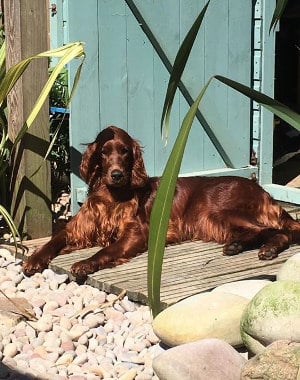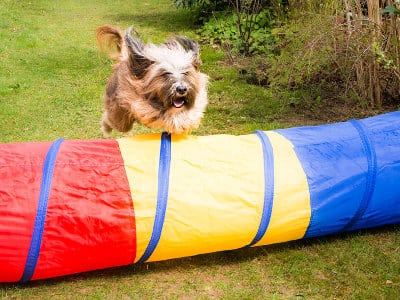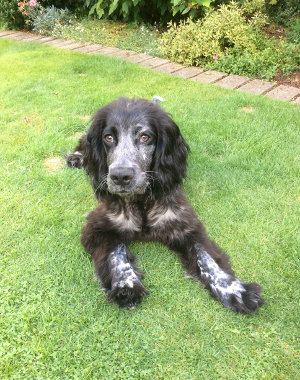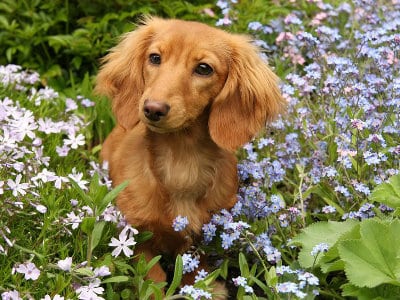Dogs may be man (or woman’s) best friend but, depending on the breed, they are not always the keen gardener’s best mate.
We’ve all seen pictures of muddy canines cheerfully transforming a nice lawn into a lunar landscape or flower beds into trenches, but does dog ownership really have to mean bidding farewell to your outdoor haven?
First of all, there are what we’ll call high and low impact dogs. Low impact dogs might leave a few scorch marks on the lawn due to the nitrogen in their urine and occasionally knock over a plant pot. If this is the issue, jump straight to ‘How to Maintain a Green Lawn’.
High impact dogs dig holes, scrape the grass, escape, eat things they shouldn’t and treat shrubs and trees as something to be slowly murdered when bored. Some breeds are known for being more destructive (I can vouch that Siberian Huskies belong on this list) than others but really just like us, all dogs are different and like us, some dogs are more partial to a spot of garden redesign than others.
If you have a high impact dog, consider, first of all, why your dog might be behaving the way he is (for convenience, we’ll consider all dogs to be boys for the purpose of this article).

Digging is the number one complaint when it comes to doggy adventures in gardening. Whether it’s scratching the surface with their paws after having a poop, burying treats or bones, digging out mice or attempting to tunnel out of the garden, this can all have an adverse impact on the look of your garden.
So why do dogs dig? When it comes to entertainment, dogs are good at filling in the gaps. There’s always the possibility your dog could be bored, feeling lonely or not getting the appropriate exercise for their needs. There’s a huge range of outdoor dog toys available to suit how you and your dog interact and the size of your garden. You can even buy home agility equipment if you want to keep their minds and bodies really active. Just remember to bring in dog toys and wash them regularly as snails and slugs can spread lungworm to your pets.
If you don’t think that’s the case then your dog could be hunting. I had a dog who wiped out the entire neighbourhood mole population within a fortnight of us moving into the property. The downside was she left damage on a far more epic scale than the moles ever managed. Your dog could even be looking for an escape route as some breeds are inclined to wander, especially if there is a girl in season nearby. And then, of course, some dogs just find digging fun.

If you have a dog who simply loves to dig, there are a few strategies at your disposal. The easiest is, of course, to supervise your dog in the garden. However, you may wish to be able to let your pup chill out unattended if you have a very secure garden, although the rise in dog thefts from properties is something we all need to be mindful of. In that case, you may want to consider sectioning off parts of the garden as designated ‘dog zones’ where your pet can dig or make a bit of a mess without ruining your planted areas or lawn. You can use decorative trellis, walls or even shrubs to create different areas depending on the size, agility and determination of your dog. Some people even have success training their dog to dig in a certain area or providing a sandpit by hiding treats and toys to encourage digging in the chosen spot.
Even if your dog is not intent on turning your garden into something reminiscent of the WW1 battlefields, having some canine pals does put some extra stress on your lawn.
Most dogs prefer to relieve themselves on grass rather than on hard surfaces. Dogs identify themselves to one another through their urine and faeces and grass accommodates this better, it’s why some dogs will scratch the ground with their hind feet after doing their business, for dogs it is all about spreading their scent and letting the world know this is their territory. Dog urine is high in nitrogen, useful in small amounts, but not so much if the dog insists on using the same spot again and again. The same as over fertilisation, repeated exposure to dog urine can damage the roots of your grass and create brown, dead spots on your beautiful lawn.
Some people resort to using artificial grass although with dogs around it is still not a maintenance free solution and you need a frequent cleaning regime to keep on top of the spots your dog favours to prevent urine odour building up.
However, with the right care and maintenance, natural lawns can be resilient to dog traffic. Use the most appropriate kind of seed/turf and apply an appropriate lawn care routine and, unless your dog is determined to tunnel to the southern hemisphere, your grass should be able to stand up to the additional stress.

A pure ryegrass sports grass mix, for example, is going to offer a good level of wear resistance and reasonable domestic appearance. In dry, free-draining gardens, especially if you live near the coast, then strong fescue or tufted hair grasses could be used in a mix.
Some people find products such as Dog Rocks prevent urine damage, but watering the area thoroughly will also help to minimize the damage by diluting the nitrogen in urine. Similarly, other gardeners find adding tomato juice to their dog’s food helps reduce grass damage, this is most likely because the salt content makes the dog drink more water which dilutes the nitrogen shed in the urine. To achieve the same result, you can add water to the food, especially useful if your dog is not a big drinker.
Many dogs can be trained to use certain areas to relieve themselves, whether it’s an out of the way spot on the ground or a post for male dogs. If dead patches do appear, they will repair themselves in time if not too large, but repairing with turf or overseeding will speed the process up.
Many dogs like to regularly patrol their territory and can create a worn path, often around the perimeter of the garden. In his head, your dog is doing his job of keeping the pack safe and sound and curtailing this behaviour will cause him stress.
One tip is to make his well-trodden path a nice feature and rather than have it marked by worn out grass or mud, use an alternative, paw friendly surface which will look attractive and enable your dog to carry on patrolling his regular route to his heart’s content. Try to choose a surface that won’t get too hot in the summer or become icy and a slip hazard during the winter.
Dogs age much quicker than we do, of course. As your dog gets on in the years, getting around may become more challenging and incorporating gentle slopes rather than steps into your garden will enable him to carry on his activities as normal even if he is getting less mobile.
Most people are aware there are plants that can be extremely toxic to dogs when eaten and definitely to be avoided when your garden is used by your pets. Also avoid having thorny and spiny plants which can cause serious eye injuries.
There are many plants that pose no threat to dogs so a dog friendly garden does not mean a plain or colourless one. There are plenty of display and ground cover plants that will not hurt your dog, even if he is inclined to have a nibble – things like Forget-Me-Not, Nasturtiums and Snapdragons are all good examples. Some herbs can be really beneficial to have around.
Even the best-behaved dog may like the occasional romp through the flower beds or shrubbery so it’s best to plan for this and plant hardier shrubs and perennials around the edge and keep the more fragile plants in the middle or in raised beds where they are less likely to be trampled if your dog has a mad half hour.

Many dogs – especially the flat faced breeds – can get too much of a good thing during the summer. Heat stroke can be a real health risk so incorporating some shade into your garden is great for dogs and their human companions alike.
While a shelter of their own is a possibility, your dog will not mind sharing a gazebo or pergola with his human family. Just remember if you have a chewer to screw some metal plates onto exposed wood that is in reach of idle teeth!
We mentioned security and dog thefts earlier. Some dogs are free spirits too who have an urge to explore the other side of the fence so you need to be confident your dog can’t dig under the fence or escape through any holes. If he is digging then you may need to set your fence deeper, bury chicken wire at the base or set slabs or stones around the bottom.
You would be surprised at how high dogs can jump or climb and if you have a medium sized dog, then you are probably looking at a 6ft fence to be safe. Don’t forget to keep the gates closed and locked too. This doesn’t mean your garden has to look like a prison camp though. There are many options when it comes to attractive fencing and even the plainest perimeter can be made to look great painted a nice colour or with the right planting in front.
While this might sound complicated and can be a little costly getting it right, the hours spent with your best friend in a lovely garden are priceless.
To keep up to date with Rolawn advice, news and special offers, please sign up to our Newsletter.
With an Honours Degree in Psychology from Durham University, and a qualification in journalism through the NCTJ, Mel draws on her knowledge of and experience in Journalism and Communications as well as her love of literature, travel and adventure to write on a range of subjects. Mel is an award-winning writer who specializes in health sector communications, but her primary passion is sled dogs and she often writes for canine-related publications and blogs.